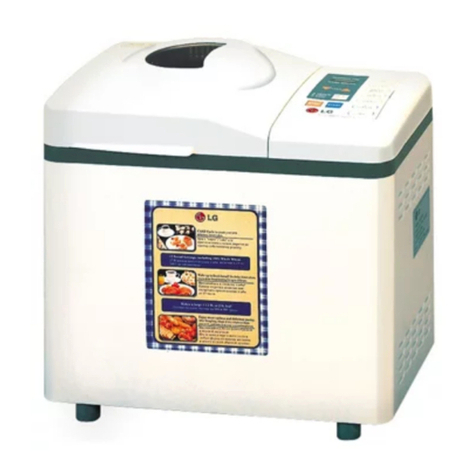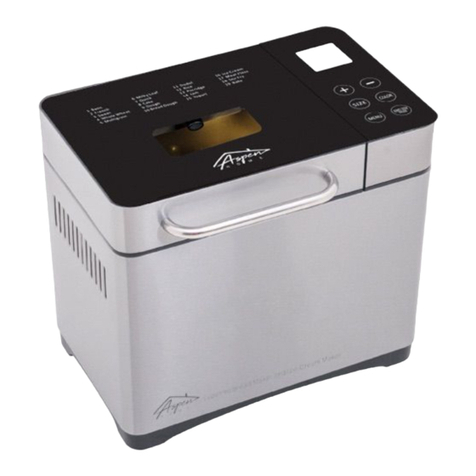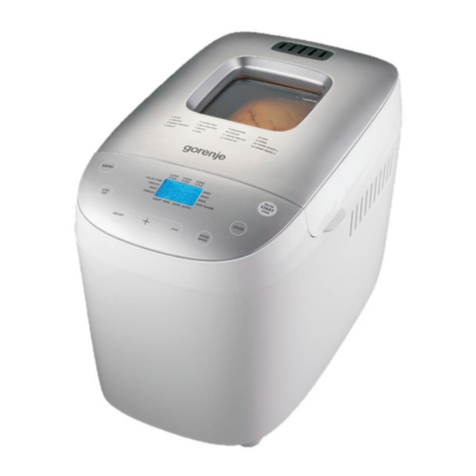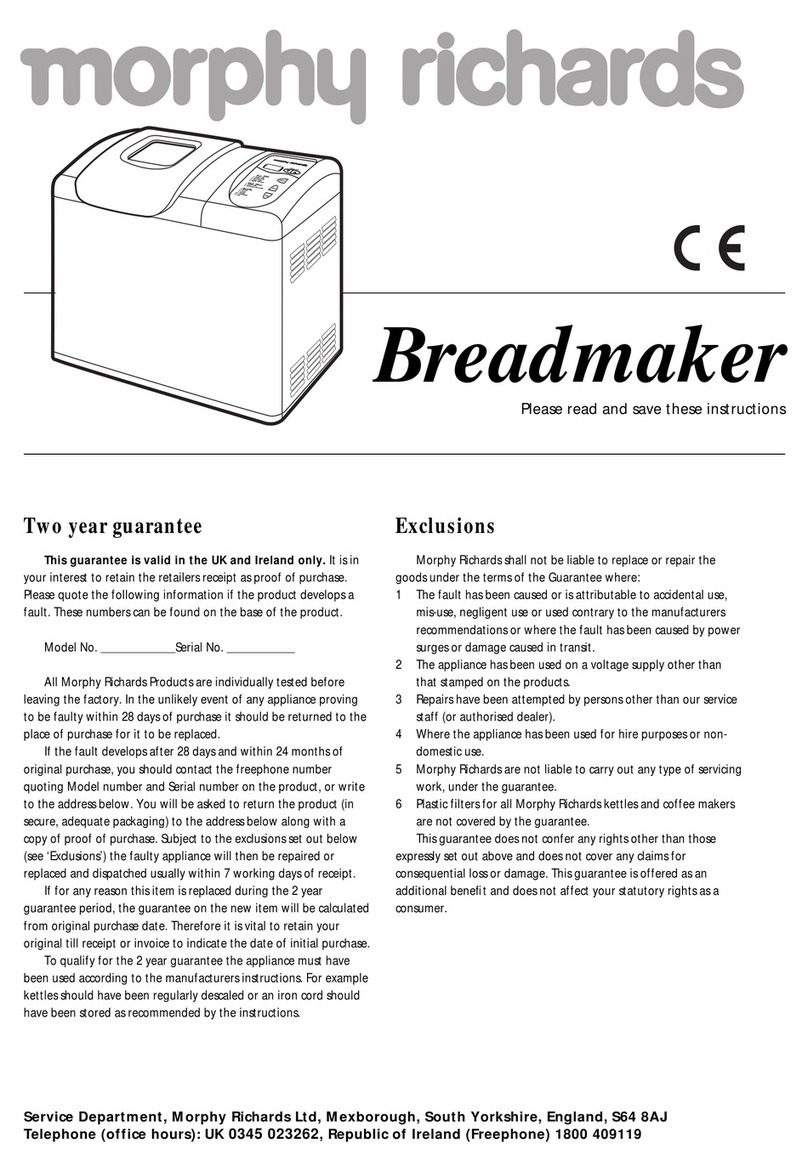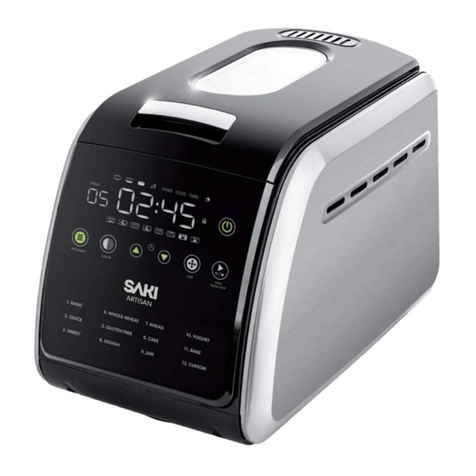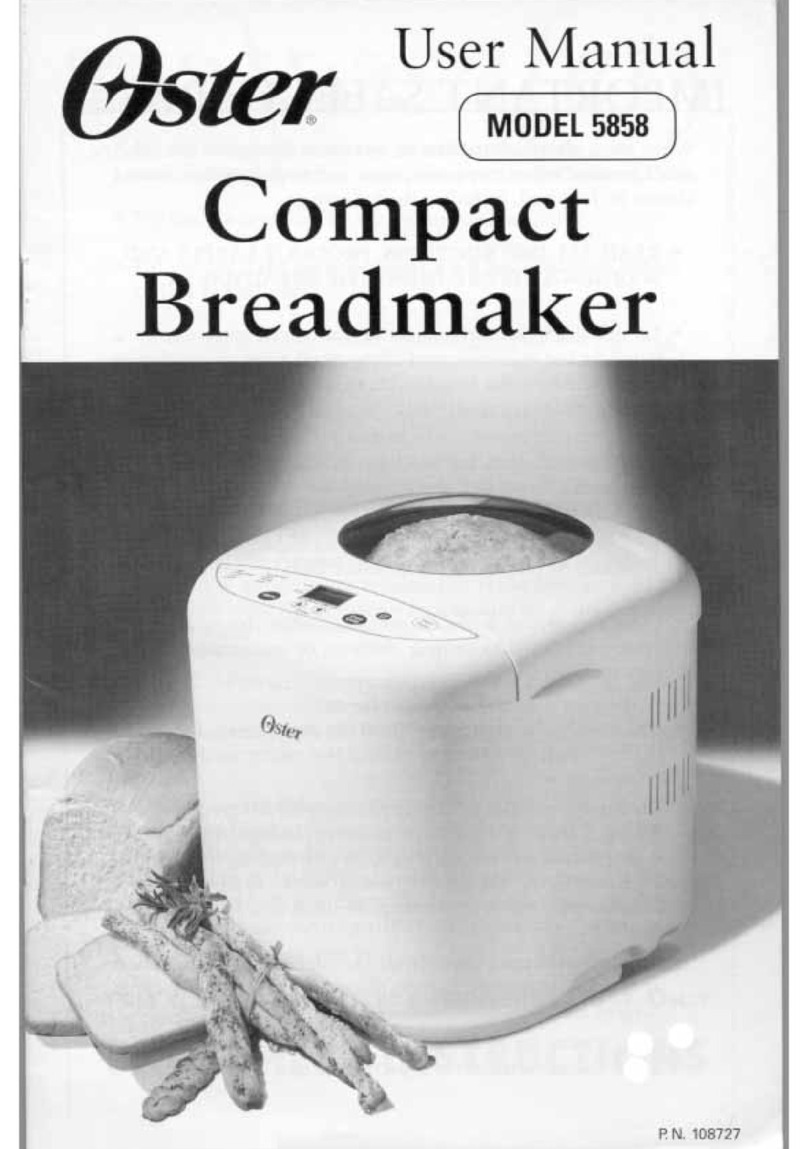AERA CBM-500 User manual

17
GB
BREAD MACHINE
INSTRUCTIONS FOR USE
AERA-Nr.: 10000182
Model: CBM-500
30075-English_2 .indd 17 24/1/07 6:29:52 PM

18
GB
19
CONTENTS
Basic safety instructions should be followed when using electrical appliances. In order to avoid the risk of
burns, electric shocks, fires and/or personal injury, please read this instruction manual carefully before
using the appliance and ensure that you follow the instructions during use.
Carefully retain this instruction manual for further use.
Should this appliance be transferred to a third party, please ensure that this instruction manual is also
transferred.
IMPORTANT SAFETY INSTRUCTIONS 19
INTRODUCTION Connecting to the mains 20
LCD display 20
Start/stop 20
Menu/program selection 21
Browning 21
Bread weight 21
Timet 3 or time 4 21
Using for first time 22
Baking bread 22
Cleaning and maintenance 23
Addition of ingredients for baking bread 23
Measuring ingredients 24
Suggested recipes for automatic bread baking 26
TECHNICAL DATA 29
DISPOSAL ADVICE 29
SERVICE / GUARANTEE 29
30075-English_2 .indd 18 24/1/07 6:29:52 PM

18
19
GB
IMPORTANT SAFETY INSTRUCTIONS
IMPORTANT SAFETY INSTRUCTIONS
• Only connect the appliance to an approved,
correctly installed plug socket. Do not use any
multi-plug adaptors or extension leads.
• The voltage annotated on the appliance label
must correspond to your mains supply voltage.
• When laying the electricity cable, ensure
that it cannot be tripped over whilst using the
appliance.
• Keep the electricity cable away from hot
surfaces, open flames and sharp edges.
• Never touch the electricity cable or plug with
damp or wet hands.
• Never immerse the appliance, the mains cable
or the electricity plug in water or other liquids.
There is a danger of electric shocks!
• When unplugging the mains connection, always
unplug it using the plug, never the cable.
• Do not use the appliance outdoors.
• Do not leave the appliance unsupervised during
use.
• The lid and exterior surfaces may become very
hot when the bread maker is in use. Only touch
the handles and switches. Use oven gloves as
necessary
• Use oven gloves when removing hot food. In
order to avoid burns from escaping steam,
please always open the lid to one side and keep
hands and face clear.
• Before cleaning, un-plug the mains connection
and allow the appliance to completely cool
down.
• Children do not recognise the dangers that can
be created by contact with electrical appliances.
Keep children away from the appliance.
Take special care whilst using the appliance if
children are in the vicinity.
• Do not use the appliance if it shows signs of
damage, if it is dropped or if it does not function
correctly.
• Do not use water to smother burning food or
appliance parts. Put out the fire with a damp
cloth. Unplug the mains connection immediately!
• Regularly check the appliance, the electricity
cable and the plug for visible signs of damage.
Under no circumstances should you use the
appliance if you have established that it
is damaged. Do not attempt to repair the
appliance yourself.
• Repairs should only be carried out by qualified
technicians.
• Only use the appliance on heat-resistant
surfaces. Do not place the appliance near to
heat sources or open fires. Never place it in a
hot oven.
• Never cover the bread maker with a towel
or any other object. Heat and steam must be
able to escape freely. A fire risk exists if the
appliance comes into contact with flammable
materials.
• The bread maker should only be used for
the stipulated functions. Please be aware
that claims for possible damages cannot be
honoured by us in the event of false use or
misappropriation.
• Never use force when operating the bread
maker. If parts of the appliance cannot be
operated without the use of force, a technician
should be consulted.
• Never touch moving or rotating appliance parts
during the baking process.
• Never switch the appliance on if the bread pan
is not correctly inserted and if it is not filled with
ingredients.
• To protect against burning and short-circuits,
never insert tinfoil or other materials into the
bread maker.
• Never hit the bread pan from above or from
the side in order to remove it. Damage can be
caused by doing this.
• The appliance is only for use in private
households and is not suitable for commercial
utilisation.
30075-English_2 .indd 19 24/1/07 6:29:52 PM

20
GB
21
INTRODUCTION / CONNECTING TO THE
MAINS / LCD DISPLAY / START/STOP
INTRODUCTION
1. Mains Plugl
2. Lid
3. Viewing Window
4. Control Panel
5. Bread Pan / Baking Tray
CONNECTING TO THE MAINS
Non appena la macchina di cottura del pane è
fissata allo zoccolo della spina, i suoni di colpo e la
macchina di cottura del pane è aspettano per uso.
Nella visualizzazione prestabilisca il programma
(il numero del menu compare: “1”) con il tempo di
esecuzione adatto di programma “3:25”.
LCD DISPLAY
In the display information is displayed to the bread
weight (characterized by a line above or below the
Braeunungsstufe and weight spezification) to the
adjusted program, the Braeunungsstufe and. In the
basic adjustment the menu number of the program
appears 1 and the program duration. After
switching on on appear the appropriate markings
at the edge of display, which the different program
sections display.
START/STOP
For starting the adjusted program you must press
once the key “start/stop”. It sounds a short beep
and the red LED light begins to burn. After the
program is started, all keys to on “start/stop” are
deactivated.
For terminating the program the key “starting/stop”
press again and a beep acknowledges the program
end.
ANM. TO THE AUDIO SIGNALS:
An audio signal sounds:
• when pressing all programmtasten,
• con determinati programmi durante il secondo
processo dʼimpastamento, per precisare che ora
aggiunte differenti (grani, frutte, Nuesse) da
essere latta aggiunta.
1
3
2
4
5
30075-English_2 .indd 20 24/1/07 6:29:53 PM

20
21
GB
MENU/PROGRAM SELECTION / BROWNING /
BREAD WEIGHT / TIME 3 OR TIME 4
• with achieving the program end,
• during the warm retaining phase.
MENU/PROGRAM SELECTION
The different programmes are set using the menu.
A programme change takes place by pressing the
“Menu” key (accompanied by a short beep). If
the key is pressed 12 times consecutively, the 12
different menus appear on the LCD-display. Simply
choose the desired programme. Please find below
a short explanation of the 12 afore-mentioned
programmes:
1. BASIC: Kneading, proving and baking normal
bread. Ingredients can be added according to
taste.
2. WHITE BREAD: Knead, allow to stand and
bake with a long rising time. The bread will
then develop a crisp crust und light consistency.
3 VOLLKORN: Kneading, proving and baking
wholemeal bread. Here the pre-heating time is
longer, this allows the grain to expand in water
and rise.
4. LEAVENED CAKE / Knead, allow to stand
and then bake sweet bread. Used for baking
crusty, sweet bread.
5. SHORT-750g / Knead, allow to stand und
bake from approx. 750 g bread for the
shortest time.
6. SHORT-1000g / As above for “SHORT-750g”,
but this time for approx. 1000 g bread.
7. COOKIES / Used for preparing dough, which
need not rise.
8. MIXED-GRAIN BREAD / Used for preparing
bread made from rye flour or a mixture of
white and rye flour.
9. DOUGH / This program handles the kneading
and ”rising“ of the dough. Once the program
has finished, the finished dough can be
removed and used to shape rolls, pizza, etc..
This program can be used to knead all raw
doughs.
10. DOUGH-LOCKER/: As specified under the
“DOUGH“ program, but with a longer
subsequent rising time.
11. Jam: To boil jams and cooking jams made
from fresh or frozen fruit. Care must be taken
to ensure that the volume of ingredients
used does not overflow from the baking
compartment during boiling. However, if this
should occur, please immediately switch off
the device. Remove the baking compartment,
allow the unit to cool down and clean it
thoroughly.
12. BAKE: For the after-baking of bread, without
kneading and rising. This can also shorten the
baking time with specific settings selected.
BROWNING
This button allows the colour of the crust to be
manually set/regulated: Light, Medium, Dark or
Quick. Select the desired option by repeatedly
pressing the button.
BREAD WEIGHT
This button allows you to choose the size of the
loaf. The duration of the programme can vary
according to the size of the loaf programmed.
TIME 3 OR TIME 4
If you do not want the appliance to start
immediately, a timer function can be programmed
with these buttons.
Input the desired completion time using the “Time
3” or the “Time 4” keys. Ensure that you account
for the programmeʼs baking time. The bread is
ready to serve once the time, which has been set
using the timer, has finished. The programme and
the degree of browning must first be chosen. The
timer time is changed in 10 minute-intervals with the
“Time 3” or the “Time 4” keys. The maximum
adjustable time is 13 hours.
ADVICE:
Do not use any easily perishable ingredients such
as eggs, fresh milk, fruit, onions, etc., when baking
using the timer.
30075-English_2 .indd 21 24/1/07 6:29:53 PM

22
GB
23
USING FOR FIRST TIME / BAKING BREAD
USING FOR FIRST TIME
1. Check that all parts and accessories are
present and damage-free.
2. Clean all parts according to the “Cleaning and
Maintenance” instructions.
3. Set the bread maker onto baking mode and
allow it to bake for approx. 10 mins without
any contents. Clean it again once it has cooled
down.
4. Carefully dry and insert all parts. The baking
machine is now ready for use.
BAKING BREAD
1. Insert the bread pan and turn it clockwise, until
it locks into place. Insert the dough hook into
the gear shaft. Turn the kneader clockwise,
until it locks into place. It is recommended that
you fill the holes with heat-resistant margarine
before inserting the kneader; this prevents the
dough from becoming stuck under the kneader
and allows it to be removed easily from the
bread.
2. Put the ingredients in the bread pan. Add the
ingredients in the order stated in the recipe.
Water or other liquids are usually inserted first,
then sugar, salt and flour. Always add yeast
or baking powder last. For firm dough mixes,
e.g. with high rye or wholemeal content, we
recommend that you reverse the order of the
ingredients. First add dry yeast and flour and
add the liquids at the end. This guarantees a
better dough mixture.
3. Make a hollow in the flour with your finger.
Place the yeast in the hollow. The yeast should
not come into contact with liquid ingredients or
salt.
4. Close the lid carefully and plug in the
appliance.
5. Choose the desired programme with the menu
button.
6. Choose the desired degree of browning with
the “colour” button.
7. The “Bread amount” button allows the desired
size to be selected (0.5 kg; 0.750 kg or 1.0 kg)
8. Set the time control function with the “Time 3”
or the “Time 4” keys. Miss out this point for
an immediate programme start.
9. The “START/STOP” is used to start the
program.
When a program with two kneading phases is
underway (indicated by beeps), you may add
extra ingredients if required. Subsequently, the
cover of the automatic bread-baker should no
longer be opened during the rising and baking
stages, since this will lead to leakage of the
vapour and moisture required for rising and
baking, leaving the bread prone to collapse.
During the baking stage, although vapour may
possibly come out of the ventilation holes, this
does not indicate any malfunction. During the
baking and rising stages, the cover should not
be opened under any circumstances, since
this will significantly worsen the quality of the
bread.
10. Program end. Once the program is complete,
00:00 is indicated on the display and a beep
is heard.
11. Warming. At the same time, a warming stage
of 1 hour commences. The bread should
have already been taken out of the baking
compartment.
12. Removing the bread. Press the STOP button
and open the cover. Warning! The baking
compartment, the inside of the unit and the
bread are all very hot! Remove the baking
compartment with the help of a dishcloth
or oven gloves! Only place the baking
compartment on a heat-resistant surface.
13. Removing the bread. Turn the baking
compartment upside down and shake it slightly.
Allow the compartment to cool down for 15
minutes as required. Subsequently, the bread
can be removed from the compartment with
the help of a wooden or plastic spoon. Do not
use any knife or other metal objects to do so,
because these will scratch the coating of the
baking compartment. Warning! If the kneading
paddle is in the bread rather than in the
compartment, remove it! Immediately rinse the
bread compartment after removing the bread,
which will make it easier to clean later on.
14. Unplug the device from the mains after each
use.
30075-English_2 .indd 22 24/1/07 6:29:53 PM

22
23
GB
BAKING BREAD / CLEANING AND
MAINTENANCE / ADDING INGREDIENTS TO
THE BAKING BREAD
15. Before baking fresh bread, the device
must be allowed to cool down. This takes
approx. 15-20 minutes, during which time the
device cannot be used for any subsequent
baking. If E:EE or H:HH is indicated on the
display, this is evidence of overheating. For
further information, see the chapter: Errors,
adjustments.
16. The device can be used in a range of ambient
temperatures, although the temperature and
humidity level will affect the quality of the
bread. With this in mind, it may be necessary
to further adapt recipes to the conditions
during baking.
ADVICE:
Before slicing the bread, remove the dough hook
using the hook that is situated under the bread.
Never remove the dough hook by hand, as the
bread is hot.
CLEANING AND MAINTENANCE
Disconnect the appliance from the mains and allow
it to cool down before cleaning.
1. Bread pan: Wipe with a damp towel inside
and out. Do not use any sharp or abrasive
instruments, as this could damage the non-
stick surface. The pan must be carefully dried
before it is inserted.
2. Dough hook: Should the dough hook rods
be difficult to remove from the shaft, fill the
container with warm water and leave it to soak
for approx. 30 minutes. Afterwards the dough
hooks can be removed and cleaned easily.
Wipe the hooks carefully with a damp cotton
cloth. Ensure that the bread pan and dough
hooks are machine washable.
3. Lid and window: Clean the lid with a soft
damp cloth inside and out.
4. Casing: Clean the outside of the casing
carefully with a damp cloth. Do not use any
abrasive instruments to clean as this could
damage the gloss surface. Never immerse the
casing in water to clean it.
5. Before storing the appliance, ensure that it has
completely cooled down and that it has been
cleaned and dried Place spoons and dough
hooks in the drawer and close the lid.
ADDING INGREDIENTS TO THE BAKING
BREAD
1. Extra-fine flour.
Bread flour contains a high proportion of
gluten and is therefore especially strong due to
its protein content. The dough becomes elastic
and does not come together after proving.
Due to its higher gluten content compared
with traditional flour, this flour is suitable for
large loaves of bread, which are less crumbly.
Bread flour is the main ingredient when baking
bread.
2. All-purpose flour
All-purpose flour is produced from a blend of
wheat and durum wheat and is suitable for fast
baking and for cooking.
3. Whole-wheat flour
Whole-wheat flour is ground wholemeal and
contains husks and grains of corn. Whole-
wheat flour is heavier and meatier than
traditional flour. Bread made from whole-
wheat flour is generally smaller. Therefore, in
order to get the best results, most recipes use a
mix of whole-wheat and bread flour.
4. Buckwheat flour
Buckwheat flour is rich in dietary fibre just like
whole-wheat flour. In order to achieve high
volume after proving, this flour must be mixed
with a large proportion of bread flour.
5. Cake flour
Cake flour consists of finely ground wheat or
low protein wheat and is especially used for
baking cakes. The different flours appear to be
the same, but the absorbency or the swelling
properties with yeast varies according to the
producing area, grinding method and the shelf
life. Therefore try different brands of flour
products in order to find the most suitable flour
for your taste.
30075-English_2 .indd 23 24/1/07 6:29:54 PM

24
GB
25
ADDING INGREDIENTS TO THE BAKING
BREAD / MEASURING THE INGREDIENTS
6. Cornflour and oatmeal
Cornflour and oatmeal consist of ground maize
and oats. They are used as an addition to
chunky bread types in order to improve the
taste and consistency.
7. Sugar
Sugar is an important addition to sweeten and
give colour to bread. It supplies nourishment
for the yeast. It is essential that white sugar is
used. Brown sugar, icing sugar and candyfloss
can also be used for certain recipes.
8. Yeast
Yeast produces fermentation materials. This
fermentation process creates carbon dioxide,
which makes the bread rise and gives it a
fluffy structure. A nutrient solution from sugar
and flour is needed to prove the yeast dough
quickly.
1 Tsp dry yeast = 3/4 tsp instant yeast
2 Tsp dry yeast = 1.5 tsp instant yeast
5 Tsp dry yeast = 33/4 1 tsp instant yeast
Yeast should be stored in a cool place, as
it dies off in high temperatures. Check the
expiry date before use. Place the remains in
the refrigerator after use. When bread doesnʼt
rise, this is mainly due to expired or died off
yeast stocks.
You can test whether the yeast is fresh or
whether it has already died off by using the
test below.
(1) Pour 1/2 a cup of warm water (45-60°C)
into a measuring jug.
(2) Add 1 tsp of white sugar and stir. Then
sprinkle 2 tsp of yeast over the water.
(3) Place the measuring jug in a warm place
for approx. 10 mins. Do not disturb the
water.
(4) The dough blows up to the measurement
mark “1 cup”. If not, the yeast has died
off.
9. Salt
Salt gives the bread taste and gives the crust
colour. Salt can, however, affect the proving of
the yeast. Therefore, never use too much salt in
the dough. Those who do not like salt can also
leave it out. Unsalted bread rises better.
10. Eggs
Eggs give the bread a better consistency, more
nutritional value and volume as well as the
typical eggy taste. Eggs are used without their
shells and are evenly whisked.
11. Fat, butter, vegetable oil
Bread is softer and lasts longer through the use
of fat. Warm butter if it has been stored in the
refrigerator or cut it into small pieces, so that
you can beat it smooth.
12. Baking powder
Baking powder is used predominantly for
extra fast bread baking and for cakes. Baking
powder doesnʼt need any proving time and
does not produce gases and it works according
to chemical principles: bubbles are made or
the consistency loosens.
13. Bicarbonate
Bicarbonate works like baking powder and can
also be used together with baking powder.
14. Water and other liquids
Water is an essential ingredient when baking
bread. Water at a temperature of between
20-25 °C is especially suitable. A temperature
of between 45-50 °C is necessary, however,
during extra-fast bread baking in order to
accelerate the proving. Water can be replaced
by fresh milk or a water mix with 2% milk
powder. The taste and the colour of the crust
are affected by this. In some recipes you will
find variants with juices (e.g. apple, orange,
lemon juice, etc.), which improve the flavour.
MEASURING THE INGREDIENTS
The success of bread baking often depends on the
exact use of ingredient quantities.
We recommend, therefore, that you use a
measuring jug and measuring spoon.
1. Measuring liquid ingredients
Water, fresh milk or dissolved milk powder can
be measured with a measuring jug.
The fill level is read from the side of the
standing measuring jug.
Always measure ingredients individually and
clean the measuring jug well afterwards.
2. Measuring dry powder
Loosen the dry powder and do not keep it
pressed. For an exact measurement, carefully
smooth the top of the cup so that it is flat.
30075-English_2 .indd 24 24/1/07 6:29:54 PM

24
25
GB
MEASURING THE INGREDIENTS
3. Order of adding the ingredients
When adding ingredients, ensure that you
follow the order below exactly. The following
order is usually valid. liquid ingredients, eggs,
salt, milk powder, etc. The flour can be totally
dampened when adding the ingredients. Only
add yeast to dry flour. Never allow yeast to
come into contact with salt. Once the flour
has been kneaded through for a while, a
beep reminds you to add aromatic ingredients
(e.g. fruit). Adding the aromatic ingredients
too early can lead to a loss of taste with long
mixes. Never use easily perishable ingredients,
such as eggs or fruit, when baking using the
timer with a long delay time.
30075-English_2 .indd 25 24/1/07 6:29:54 PM

26
GB
27
BREAD MAKER RECIPE SUGGESTIONS
30075-English_2 .indd 26 24/1/07 6:29:54 PM

26
27
GB
BREAD MAKER RECIPE SUGGESTIONS
30075-English_2 .indd 27 24/1/07 6:29:55 PM

28
GB
29
BREAD MAKER RECIPE SUGGESTIONS
30075-English_2 .indd 28 24/1/07 6:29:55 PM

28
29
GB
TECHNISCHE DATEN
BREAD MAKER RECIPE SUGGESTIONS /
TECHNISCHE DATEN / DISPOSAL ADVICE /
SERVICE / GUARANTEE
Voltage 230 V ~ 50 Hz
Rated output 450 Watt
DISPOSAL ADVICE
• Old electrical appliances do not belong with household rubbish. The law requires that
old appliances must be disposed of at a local authority collection point or a bulky
waste collection.
• This ensures that old appliances are correctly disposed of and utilised.
SERVICE / GUARANTEE
The product is guaranteed is for 3 years beginning from the date of purchase. Ensure that you retain the
receipt as proof of the date of purchase.
The guarantee is valid for appliances bought in Germany. It covers defects and malfunctions, which occur
through normal use within the guarantee time and which are traced back to material or processing faults.
In the event of a guarantee claim, you are not liable for any repair costs.
The guarantee is cancelled through damage, alterations or improper use of the appliance, if these lay
outside of the guarantorʼs area of responsibility. This is especially valid in the following cases:
• ntervention inside the appliance by an unauthorised person.
• Alterations on or inside the appliance, the removal or defacing of the serial number or the removal or
alteration of the appliance seal.
• With damages caused by blows, falls or other effects.
• With damages caused by improper handling or use.
• With damages through external sources, such as excess voltage or lightening strike.
• Commercial use of the appliance.
Your statutory rights in the case of any deficiency in the device (subsequent delivery, cancellation,
deterioration, compensation, and so on in accordance with § 437 BGB) will remain unaffected by this
guarantee.
• Sugars from the edge of the container with putty
remove.
• If the acoustic signal sounds, which containers
with furnace gloves remove from the device.
Jam in glasses of rackings and these firmly lock.
30075-English_2 .indd 29 24/1/07 6:29:56 PM

30
GB
SERVICE / GARANTIE
Please retain the original packaging in case the appliance needs to be sent for repair.
Repaired or exchanged components are generally subject to the applianceʼs remaining guarantee duration.
Should you have any questions regarding the product or this instruction manual, or if you find any possible
problems with the product, please contact our Service Hotline directly in order to discuss further action.
HOTLINE/EU: (0049) - (0)1805 64 66 66*
( * 0.14 €/MINUTE FROM THE DEUTSCHE TELEKOM NETWORK)
IMPORTANT NOTE:
Please do not send your unit to our address unless requested. Always contact our service hotline
beforehand. The costs and risk of loss when sending unrequested articles are the responsibility of the
sender. We reserve the right to refuse to accept unrequested deliveries or to return relevant items back to
the sender at charge.
ITEM NO. 10000182
Manufactured by:
China Resources Electrical Appliance (Zhuhai) Co., Ltd.
for:
AERA Rundfunk und Fernseh GmbH
Hanns-Martin-Schleyer Strasse 2
D-77656 Offenburg
30075-English_2 .indd 30 24/1/07 6:29:56 PM
Table of contents
Popular Bread Maker manuals by other brands
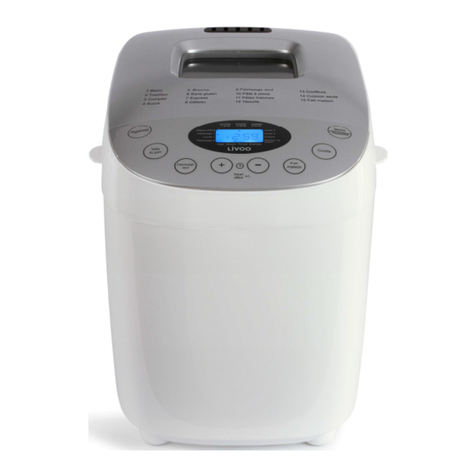
Livoo
Livoo DOP205 user manual
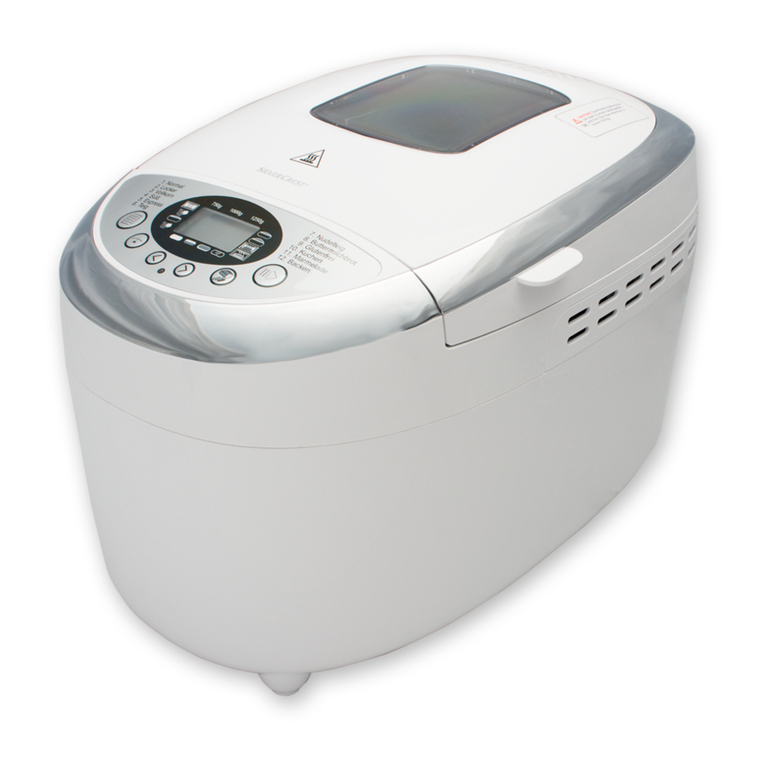
Silvercrest
Silvercrest SBB 850 B1 operating instructions
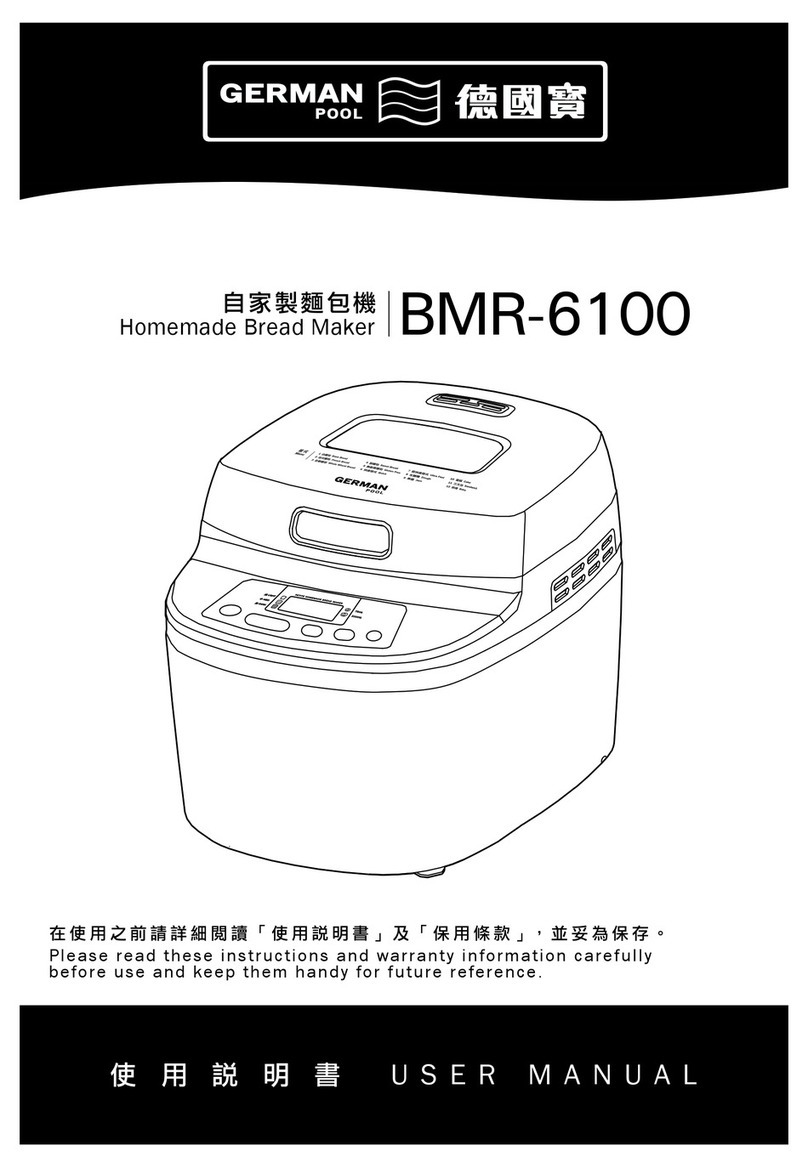
German pool
German pool BMR-6100 user manual
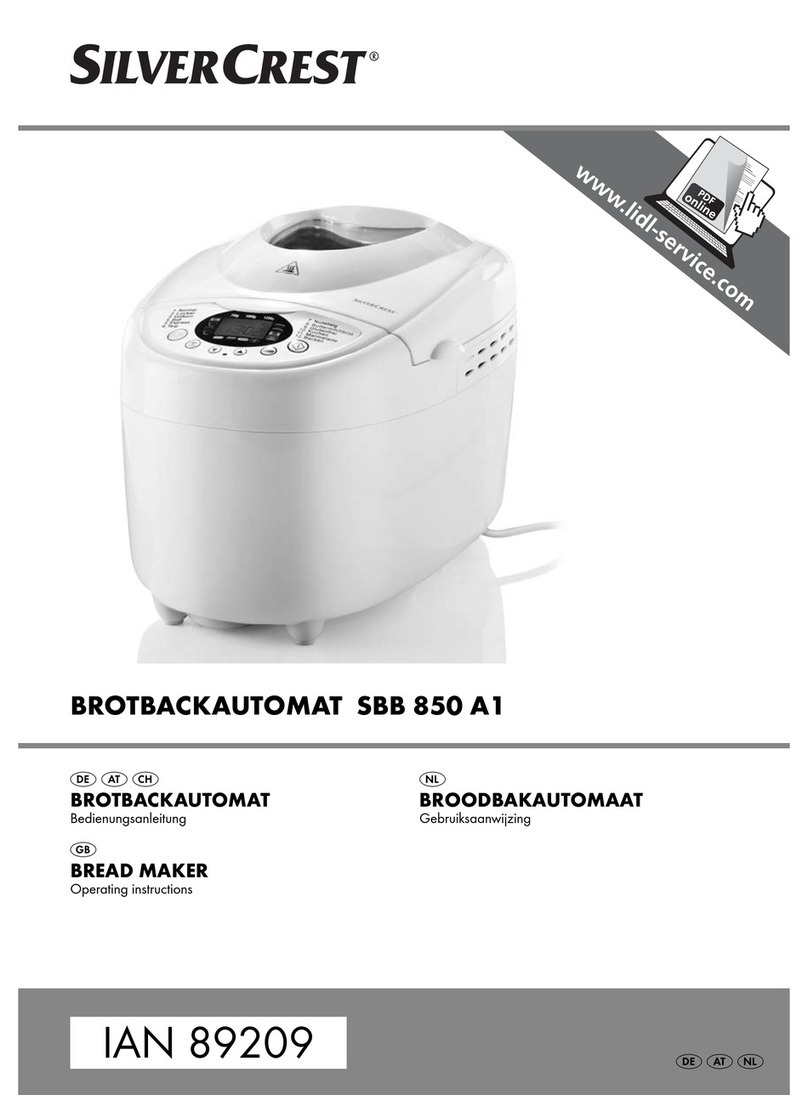
Silvercrest
Silvercrest SBB 850 EDS A1 operating instructions

Silvercrest
Silvercrest SBB 850 EDS A1 operating instructions
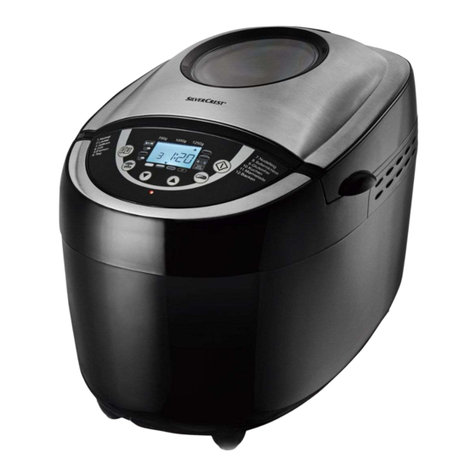
Silvercrest
Silvercrest SBB 850 C1 operating instructions
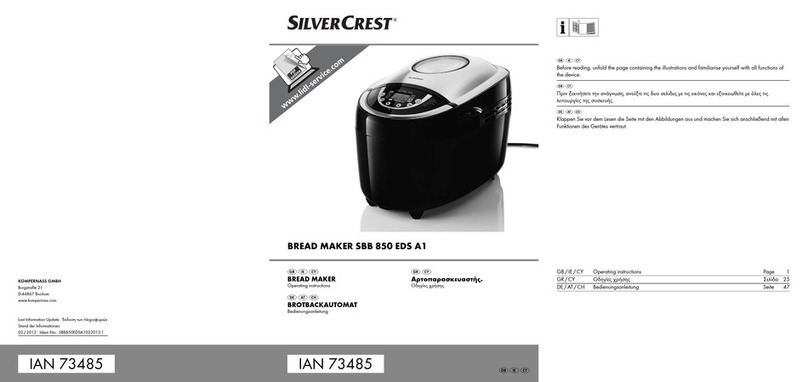
Silvercrest
Silvercrest SBB 850 EDS A1 73485 operating instructions
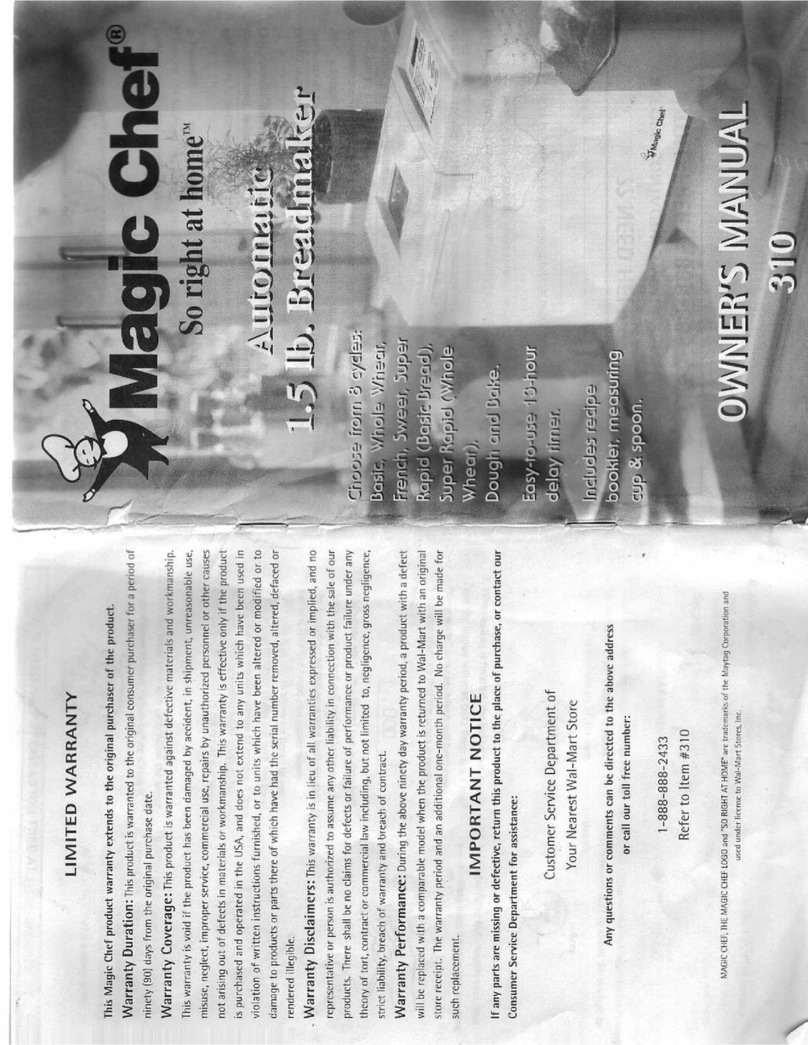
Magic Chef
Magic Chef 310 owner's manual

Silvercrest
Silvercrest eds sbb 850 b1 operating instructions
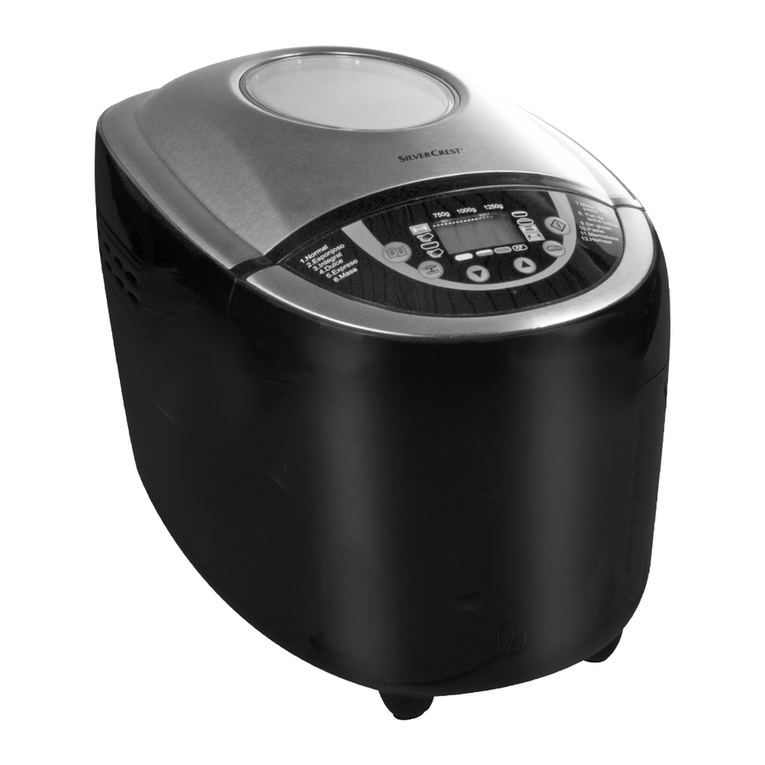
Silvercrest
Silvercrest SBB 850 EDS A1 operating instructions
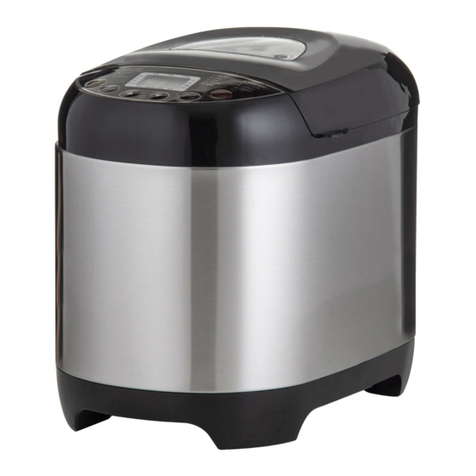
Masterpro
Masterpro 17 IN 1 ULTIMATE instruction manual

Panasonic
Panasonic SD-255 Operating instructions and recipes
